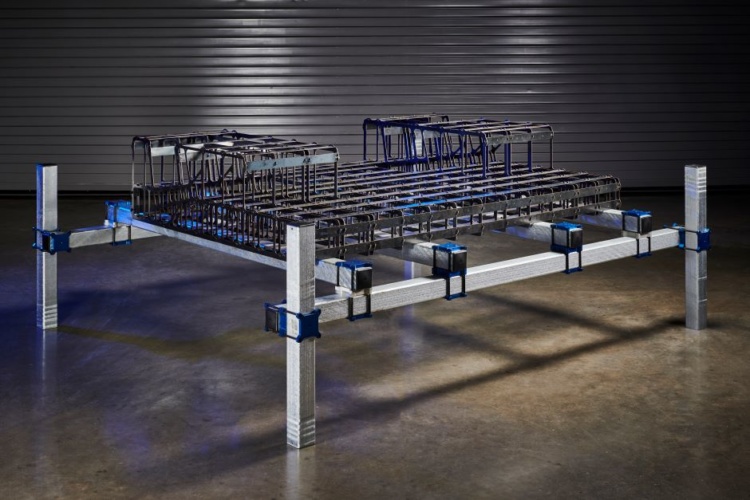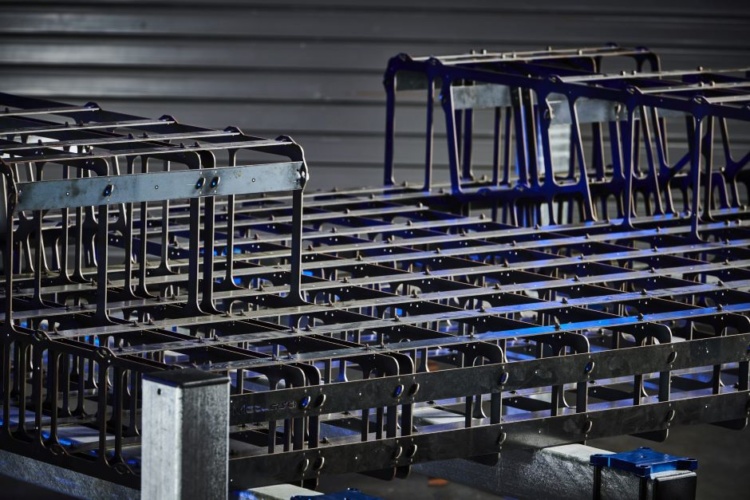C2I 2020
Category: Manufacturing technology
Winner: Concrete Reinforcement of the Future
Partners: MTC, MetLase, ParaPy, Leeds Beckett University
Category Sponsor: Mazak
Erecting steel structures is a hazardous occupation and a staggering 60 per cent of construction accidents can be attributed to workers being injured by rebar.
Rebar is made from different grades of steel and, as its name suggests, is used to reinforce the tensile strength of concrete structures. It is supplied in the form of rods and is fabricated into cage structures by hand before being encased in concrete to carry out its vital, unseen function.
Workers stooping to tie rebar at intersections can develop musculoskeletal disorders and a Labour Force Survey (LFS) from 2018/19 estimated 42,000 work-related cases of such injury, accumulating to three fifths of all ill health in this sector.
Skilled workers are pivotal to the reliable and repeatable application of rebar but reliance on them can be time-consuming and costly when scheduling of labour and materials goes wrong.
In an effort to address these issues - and maintain viability in a global rebar market expected to be worth $246.3bn by 2025 - MTC led a collaborative project with partners MetLase, ParaPy and Leeds Beckett University to reimagine how reinforced concrete is manufactured and assembled.
Liam Hill, an Advanced Research Engineer at MTC, explained that MetLase has redesigned rebar cage using laser cutting to produce sheet steel reinforcement from structural grade thin gauge sheet steel.
“This enables the designer freedom to produce complex shapes and optimised structural components that would not be possible with standard rebar,” said Hill. “This increase in design flexibility and optimisation allows for reinforcing steel to be accurately positioned only where required thus reducing the overall reinforcement – 60 per cent in certain applications.”
FIND OUT MORE ABOUT THIS YEAR'S MANUFACTURING TECHNOLOGY SHORTLIST
Hill added that less steel means less embodied carbon, which can be reduced by up to 10 per cent using the new method.
“As there is currently no feasible alternatives to concrete, every effort should be made to reduce the environmental impact,” he said.
Like regular rebar, the sheet steel rebar must be fixed into place, and MetLase’s patented fastening marks the next area of award-winning innovation innovation.
Instead of twisting ties at intermittent locations with varying degrees of accuracy the new method sees twist dowels secured into position using a spanner with minimal force to fasten two components together.
“Due to the precision in which a laser cutter can manufacture the components and twist dowels, the accuracy and repeatability of the final assembly is exponentially greater and can be quantified to calculate whole life performance,” Hill said. “The flexibility and speed of the laser cutting process and form enables Standard Operating Procedures to be incorporated, uniquely identifying individual components, providing the assembly methodology to the operator. This allows unskilled labour to identify the components and assemble them without any prior technical training and experience.”

To test the feasibility of the method, MTC staff unskilled in construction assembled the MetLase structure, when shipped flat-packed, in four hours compared to the 24 hours it took with an equivalent rebar cage.
This increase in productivity, plus the ability to use unskilled labour, could potentially save £1.35bn on labour time and 54 million hours for the construction industry each year. Furthermore, metrology analysis completed by MTC found the future state cage to be within 4mm of the design for flatness and perpendicularity, and within <1mm of the design for length and width.
“This is in comparison to the traditional cage, which deviated from the design by 6-112mm,” Hill said “This improved accuracy and quality can result in the lifecycle of the product being quantified in a more precise scientific manner, leading to fewer unforeseen failures of reinforced concrete.”
As part of the collaboration, Netherlands based ParaPy helped MTC in the development of a Knowledge Based Engineering (KBE) approach to the design of sheet metal rebar that Hill said ‘could revolutionise the design process’.

Engineers currently design a structure based on predefined loads and building designs. The process takes months to complete due to the large amount of manual, repetitive and time-consuming tasks.
“This KBE approach utilises interactive modelling to specify top-level inputs such as height, number of floors, and floor slab and column variables,” Hill said. “Loading conditions are then specified before performing a structural analysis and finally exporting the designs to a laser cutter, to be nested and cut. This has the ability to replace the lengthy design process with a rules-based and highly automated approach, reducing the design time to a matter of days.”
The project arose from MTC’s role in the Construction Innovation Hub which brings together world-class expertise from the BRE, The Manufacturing Technology Centre and the Centre for Digital Built Britain received £72m in funding from the UK Research and Innovation’s Industrial Strategy Challenge Fund to transform the construction sector through manufacturing technologies, and digital ways of working.
MTC conducted a state-of-the art review to assess the effectiveness of traditional rebar, evaluating recent research, and identifying opportunities for innovation. They then instigated the collaboration drawing in experts from industry, RTO and academia.
According to Hill, MetLase, a joint venture between Rolls-Royce and Unipart, were keen to apply their engineering pedigree and expertise to the development of laser cut reinforcement for the construction industry. ParaPy’s contribution was delivered virtually and has seen MetLase expressing an interest in further collaboration with the Dutch company to identify how KBE can be applied to their tooling and fixturing solutions.
“Without the wide variety of skills and experience, the project would not have been the success that it is today,” said Hill. “The project partners have varying experience of different sectors including aerospace, construction and automotive, amongst others. This allowed for cross-pollination and knowledge transfer of technology, processes and alternative mind-sets from sectors where productivity and safety are known to be superior. All this took places over a matter of months rather than years.
CLICK HERE FOR MORE C2I 2020 COVERAGE
About the category sponsor
Mazak
Yamazaki Mazak was established in 1919 and has been contributing to the development of the machine tool industry as a leading global company. Yamazaki Mazak manufactures not only advanced machine tools such as multi-tasking centres, CNC turning centres, machining centres and laser processing machines as well as automation systems.

Red Bull makes hydrogen fuel cell play with AVL
Formula 1 is an anachronistic anomaly where its only cutting edge is in engine development. The rules prohibit any real innovation and there would be...